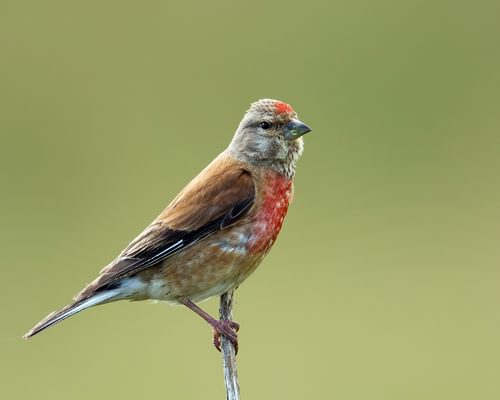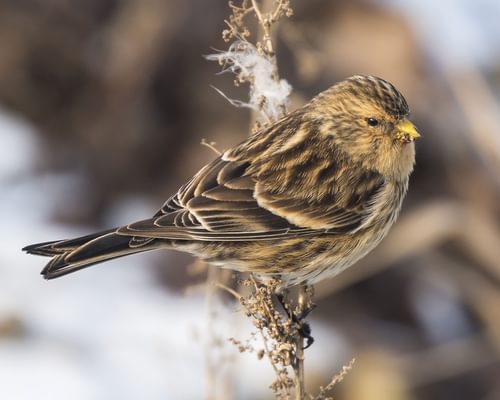Common Redpoll
Least ConcernAcanthis flammea
Visual Identification
Appearance
The Common Redpoll is a small, streaky finch with a distinctive red forehead patch and black chin. Its body is primarily brown and white, with streaked flanks and a small, pointed yellow bill. Males display a rosy pink wash on their chest and rump.
Females are similar but lack the pink coloration, appearing more buff-brown overall. Juveniles resemble females but lack the red forehead patch until their first molt.
Size
Length
11.5cm to 14cm
Wingspan
19cm to 22cm
Weight
10g to 18g
Habitat and Distribution
Habitats
Woodland
Garden
Wetland
Coastal
Urban
Farmland
Grassland
Desert
Tundra
Rainforest
Mountain
Savanna
Distribution
Common Redpolls inhabit boreal forests, open woodland, and Arctic tundra across northern North America, Europe, and Asia. They breed in these northern regions, including Alaska, Canada, Scandinavia, and Siberia.
During winter, they may move southward in search of food, occasionally reaching the northern United States, UK, and central Europe in large numbers during irruptive years.
Elevation Range
Sea level to 3,000 meters
Climate zones
Subarctic, Temperate
Distribution Map
This map gives you a rough idea of where you might spot a Common Redpoll. The coloured areas show countries where these birds have been seen.
A few things to keep in mind:
- Birds might not be everywhere in the coloured areas, for example, they may be present around the coast of that country
- Where birds live can change with seasons and available food
- This map is quite simple - it doesn't show exact locations
We're working on making our maps even better! Soon, we hope to show you:
- More detailed maps for bigger countries, including state and region
- How birds move around during different seasons
Distribution by Region
Behaviour and Ecology
Bird Attributes
This feature is in beta. We'd love your feedback to improve it!
Share your thoughtsBird Attributes Explained
Our bird attributes system rates various aspects of a bird's capabilities on a scale of 0-100, based on data from field observations, scientific studies, and expert knowledge.
Attribute Categories:
- Agility: Manoeuvrability, speed, and grace in flight or movement.
- Strength: Physical power, often correlating with size and hunting abilities.
- Adaptability: Ability to thrive in various environments or changing conditions.
- Aggressiveness: Territorial behaviour and assertiveness, particularly during breeding seasons.
- Endurance: Stamina, often seen in migration patterns or foraging behaviours.
Understanding the Ratings:
- 0-20: Very Low
- 21-40: Low
- 41-60: Average
- 61-80: High
- 81-100: Very High
Remember, these attributes are relative to other bird species and don't necessarily indicate superiority.
Hover over the icon next to each attribute for more information.
Tap the icon next to each attribute for more information.
Agility
Reflects the bird's manoeuvrability, speed, and grace in flight or movement.
The Common Redpoll displays remarkable agility, particularly in its feeding habits. Its ability to hang upside down from branch tips and perform acrobatic manoeuvres whilst foraging demonstrates exceptional dexterity and balance. The bird's aerial displays during courtship further attest to its nimble nature.
Strength
Indicates the bird's physical power, often correlating with size and hunting abilities.
As a small finch, the Common Redpoll's strength is relatively modest. Whilst capable of withstanding harsh climates, its physical power is limited compared to larger birds. However, its ability to crack open small seeds does indicate some degree of beak strength.
Adaptability
Represents the bird's ability to thrive in various environments or changing conditions.
The Common Redpoll exhibits extraordinary adaptability. Its capacity to survive temperatures as low as -65°C, tunnel into snow for protection, and adjust its range during irruptive years showcases remarkable resilience. The specialised esophagus for seed storage further demonstrates its adaptive prowess.
Aggressiveness
Measures the bird's territorial behaviour and assertiveness, particularly during breeding seasons.
Generally, Common Redpolls are not particularly aggressive birds. They are highly social, often seen in large flocks, which suggests a relatively peaceful disposition. However, like most birds, they may display some territorial behaviour during breeding season, hence the modest score.
Endurance
Reflects the bird's stamina, often seen in migration patterns or foraging behaviours.
The Common Redpoll's endurance is impressive, especially considering its small size. Its ability to survive extreme cold, undertake long migrations during irruptive years, and maintain activity in harsh winter conditions all point to exceptional stamina and resilience.
Diet
Common Redpolls mainly feed on small seeds, especially those of birch, alder, and other northern trees. They also consume buds, catkins, and insects during the breeding season.
Their specialized oesophagus allows them to store seeds temporarily, enabling feeding in exposed areas before retreating to shelter.
Behaviour
Common Redpolls are highly social, often seen in large, twittering flocks during winter. They are agile feeders, frequently hanging upside down on branch tips or seed heads to reach food.
During the breeding season, males perform aerial displays, singing while flying in wide circles to attract mates.
Vocalisation
Common Redpolls have a variety of calls, including a characteristic 'chut-chut-chut' in flight and a 'swee-ee-eet' contact call.
Their song, often heard during the breeding season, is a rapid series of trills and twitters, sometimes described as 'per-chik-o-ree' or 'chutta-chutta-chutta-chew'.
Nesting & Breeding
Common Redpolls form monogamous pairs during the breeding season, which typically begins in late spring. Males court females with aerial displays and soft warbling songs.
Nests are built by females, usually in low shrubs or on the ground. They are cup-shaped and constructed with twigs, grass, and moss, lined with feathers and plant down. Females lay 4-6 pale blue-green eggs with reddish-brown spots.
Incubation lasts about 11 days, performed solely by the female. Both parents feed the nestlings, which fledge after 9-14 days but remain dependent on adults for another two weeks.
Lifespan
years
The Common Redpoll typically lives for 2 to 5 years.
Like all birds, lifespan can be affected by factors including predation, habitat quality, disease, and access to food sources.
Conservation and Status
Global Conservation Status
While currently listed as Least Concern, Common Redpolls face threats from climate change affecting their breeding habitats. Conservation efforts focus on protecting boreal forests and Arctic tundra ecosystems.
Providing winter food sources in southern regions can also support populations during irruption years.
Birdwatching Tips
- Look for flocks feeding on birch or alder trees in winter
- Listen for their distinctive 'chut-chut-chut' call while in flight
- Check backyard feeders during irruption years in southern parts of their range
- Observe their acrobatic feeding behavior, often hanging upside down
Additional Information
Quick Facts
Other names:
Redpoll, Mealy Redpoll
Family:
FringillidaePredators
Did You Know?
- Common Redpolls can survive temperatures as low as -65°C (-85°F).
- They have a special pouch in their oesophagus to store seeds for later consumption.
- During severe weather, these birds may tunnel into snow for insulation and protection.
Was this bird profile helpful?
Your feedback helps us improve our content
Thanks for your feedback!
Your input helps us improve our content.
Community Experience
Community Ratings
No ratings yet - be the first to rate this bird!
Latest Community Reviews
No reviews yet
Sign in to be the first to review
Community Reviews
Create Your Free Account Welcome Back!
Join our community to rate birds and share your experiences. Creating an account is completely free and only takes a minute. Sign in to your account to rate birds and share your experiences with our community.
Your information is secure and will never be shared.
By creating an account, you agree to our Privacy Policy.
FAQs
How do you attract Redpolls?
Particularly in winter, when their natural sources of tree seeds may be running low, redpolls may venture into gardens to visit well-stocked feeders.
Niger seeds are a particular favorite.
Similar Birds
References
- 1 2 3
website: BirdLife International. 2019. Acanthis flammea (amended version of 2018 assessment). The IUCN Red List of Threatened Species 2019: e.T22725044A155292529.
View source


